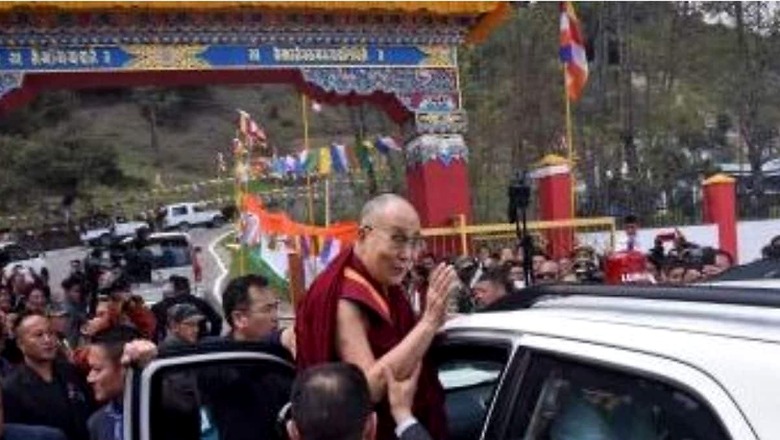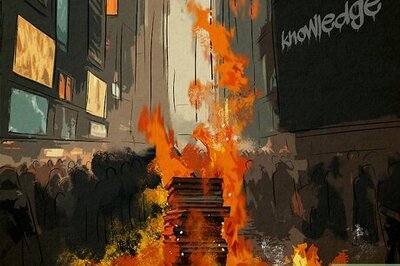
views
With reports in the media suggesting that a US-born Mongolian boy has been recognised as the incarnation of the third most important spiritual leader in Tibetan Buddhism, China’s worst nightmare seems to be turning into a reality. The eight-year-old boy has reportedly been regarded as the 10th Khalkha Jetsun Dhampa Rinpoche by none other than the 14th Dalai Lama during the ceremony in Dharamshala, Himachal Pradesh, where the 87-year-old Tibetan leader has been living in exile since his escape from Lhasa in 1959.
The Chinese government has been on an overdrive for quite some time to make sure that the Tibetan leadership is selected through communist party regulations. It is especially obsessed with the selection of the 15th Dalai Lama, saying he would need to have the Chinese Communist Party (CCP) blessings. In fact, The Global Times, a CCP mouthpiece, in a 22 February 2023 article, ‘Recognition of new Dalai Lama must be conducted in China’ (https://www.globaltimes.cn/page/202302/1285980.shtml), while asserting that the Dalai Lama and the Panchen Lama (whose selection has already been compromised by communist manipulation) hold equal positions in Tibetan Buddhism, said that the process of their selection “has been supervised by the Chinese Central Government and conducted within Chinese territory since the late 13th century”.
“The reincarnation convention of Living Buddhas in Xizang was established during the Yuan Dynasty (1271-1368), developed in the Ming Dynasty (1368-1644) and improved during the Qing Dynasty (1644-1911) under the administration of the central government,” the article said, as it emphasised how in 1653, “when the 5th Dalai Lama came to Beijing, the Emperor Shunzhi officially conferred the title of Dalai Lama on him”. This “marked the first time that the title of Dalai Lama was granted by the central government”.
Truth and fair play have never been the strongest points of the communist regime in China. Anyone even partly acquainted with Tibetan Buddhism would know that the Dalai Lama and the Panchen Lama never held “equal position”. Equally ludicrous is the claim that Tibet was always a Chinese territory. It was only after Mao’s troops invaded the Roof of the World in 1950 that Tibetans came under Chinese control. Traditional China was just a third of the area it is today. It became what it is through the combination of communist planning, deception and force in Xinjiang, Tibet and Inner Mongolia.
In an article in 1965, noted historian RC Majumdar explained an innate imperialist tendency among the Chinese from the third century BC to the present day: “It is characteristic of China that if a region once acknowledged her nominal suzerainty even for a short period, she would regard it as a part of her empire forever and would automatically revive her claim over it even after a thousand years whenever there was a chance of enforcing it.”
Interestingly, the Chinese, especially of the communist hue, don’t always scream to forward their undue claims; they at times keep quiet to indulge in a subterfuge. Former Foreign Secretary Shyam Saran narrated a story during a public lecture in 2012. Referring to a conversation between former Secretary-General, Ministry of External Affairs, RK Nehru, and Chinese Premier Chou En-lai in 1962, just before the big war, Saran said, “RK Nehru drew attention to reports that China was leaning towards the Pakistani position that Jammu & Kashmir was a disputed territory. He recalled to Chou an earlier conversation, where when asked whether China accepted Indian sovereignty over J&K, he had said rhetorically — has China ever said that it does not accept Indian sovereignty over J&K, or words to that effect. At this latest encounter, Chou turned the same formulation on its head, to ask: Has China ever said that India has sovereignty over J&K?”
Be it through Mao’s strong-arm tactics or Deng’s quiet diplomacy, the fact is the communists in Beijing have always wanted to tamper with the selection of the top Tibetan spiritual leadership, especially that of the Dalai Lama. And the recent Dharamshala incident would make them realise that their dubious succession plan won’t be a cake walk. If the Tibetan leadership has managed to find the 10th Khalkha Jetsun Dhampa Rinpoche, who is the third most important spiritual leader in Tibetan Buddhism, after the Dalai Lama and the Panchen Lama, outside Tibet, much against the Chinese diktat that warranted the search for the top Tibetan leadership to be “conducted within Chinese territory”, what’s the guarantee that the successor to the 14th Dalai Lama won’t be found outside, especially India? More so when the current Dalai Lama himself is living in an exile in India. The Chinese government could tamper with the selection of the Panchen Lama just because he was found in Tibet. Things won’t be easy beyond its frontiers.
But for that the current Tibetan leadership has to make certain amends. The 14th Dalai Lama writes in his memoirs, My Land and My People, how with the passing of the 13th Dalai Lama, the search began for his reincarnation, for each Dalai Lama is a reincarnation of his predecessor. “First, a Regent had to be appointed by the National Assembly to govern the country until the new reincarnation could be found and grow to maturity. Then, in accordance with the time-honoured customs and traditions, the state oracles and learned lamas were consulted — as a first step towards finding out where the reincarnation had appeared. Curious cloud formations were seen in the northeast from Lhasa. It was recalled that after the Dalai Lama died, his body was placed seated on a throne in the Norbulingka, his summer residence in Lhasa, facing towards the south; but after a few days it was seen that the face had turned towards the east. And on a wooden pillar on the northeastern side of the shrine where the body sat, a great star-shaped fungus suddenly appeared. All this and other evidence indicated the direction where the new Dalai Lama should be sought,” he writes.
These spiritual signs and visions helped find Lhamo Thondup, who would become the 14th Dalai Lama in 1940, six years after his birth in a farming family at Taktser. But can the Tibetans blindly follow these traditions, given the fact that the Chinese authorities are waiting with bated breath to distort the selection process, as they did in 1995 when the Chinese government detained the Dalai Lama’s choice for the successor of the 10th Panchen Lama, named Gendun Choeki Nyima, when he was six years old. Since then Beijing has refused to give details of his whereabouts. When the Tibetan people revolted, the Chinese government responded by appointing its own Panchen Lama. Today, as there are two Panchen Lamas, thanks to the Chinese subterfuge, what’s the guarantee that there couldn’t be two Dalai Lamas in future?
The very fact that the institution of the Dalai Lama is most revered in the Tibetan tradition makes it more prone to Chinese attack and distortion. Lodi Gyaltsen Gyari writes in his just released book, The Dalai Lama’s Special Envoy: Memoirs of a Lifetime in Pursuit of a Reunited Tibet, “The role of the Lama, or the teacher, is the cornerstone of our religious practice, so much so that when we recite the Refuge prayer, Homage to the Guru precedes Homage to the Buddha, the Dharma, and the Sangha. This is not to diminish the central importance of the Three Jewels, but rather to recognise the Lama as the embodiment of all three. Within all the traditions of Tibetan Buddhism, the very first salutation is as follows: Homage to the Guru; Homage to the Buddha; Homage to the Dharma; Homage to the Sangha.”
The utmost significance of the institution of the Dalai Lama makes it susceptible to Chinese assaults. It is this fear that has made the 14th Dalai Lama say so many things about the institution of the Dalai Lama — from it outliving its utility, to asking people to decide if they want to continue the Dalai Lama lineage.
The institution of the Dalai Lama is an important Tibetan bulwark against the hegemonistic Chinese forces. It’s the moral duty of the current Dalai Lama to ensure that this is well guarded and secured even after he is gone. One option for him can be to tweak the Tibetan tradition to ensure that his successor is not just announced well before his death; he can also extend the domain of reincarnation process beyond the Tibetan frontiers. Maybe since the current Dalai Lama is in exile in India, it’s logical to think that his successor would be born on Indian soil as well. This would not just outwit the Chinese waiting to manipulate the succession process, but also give the wise Dalai Lama enough time to transfer his spiritual wisdom to the successor.
The recognition of the eight-year-old Mongolian boy as the 10th Khalkha Jetsun Dhampa Rinpoche has stumped the Xi Jinping dispensation. One won’t be surprised to see China orchestrating a media blitz on how the next Dalai Lama has to have Beijing’s blessings, besides greater pressure being put on countries like India and Mongolia to not entertain such Tibetan ‘fancies’. Lodi Gyaltsen Gyari’s The Dalai Lama’s Special Envoy rightly says, “As Beijing passes laws asserting control over selection of the next Dalai Lama and pressures Mongolia and India to deny that right to Tibetan Buddhist spiritual leaders beyond China’s borders, it is becoming obvious that the many millions of devout followers of His Holiness across Asia will refuse to accept a pretender.”
Now that’s real worry for Xi Jinping: He knows it well that he can’t push the Modi dispensation beyond a point, a trailer for which has been shown by the Indian troops on the Line of Actual Control (LAC) for almost three years now. And in this scenario, if the 15th Dalai Lama reincarnates in India, and that too before the death of the current one, it would be game up for the Chinese Tibetan stratagem. At least for the time being.
The author is Opinion Editor, Firstpost and News18. He tweets from @Utpal_Kumar1. Views expressed are personal.
Read all the Latest Opinions here




















Comments
0 comment